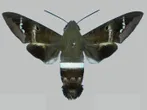Harmful Effects of Common Grizzled Hawkmoth
A species of Dolbina
Common Grizzled Hawkmoth poses risks to plants by feeding on Lamiaceae family members, such as mint and sage, causing leaf damage that can reduce photosynthesis, weaken plant vigor, and impair growth and reproduction.
What Type of Pest Is Common Grizzled Hawkmoth?









AI entomologist in your pocket
Scan QR code to download

